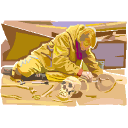| Prior to this lesson, you have been
working with
the concepts of Steno's Laws, radiometric dating, and geological
time.
The "Understanding Geological Time" website you visited at the end of
Assignment
4 briefly introduced the concept of using fossils to study prehistoric
Earth and estimate geological time. This week's activity will
focus
specifically on fossils, what they are, and their significance to the
study
of the history of this planet.
In order to gain some more background
knowledge
on fossils, visit the following interactive website. Carefully
work
your way through the site. Pay close attention to the animations,
vocabulary, and questions posed in the activity. Understanding
the
content of this website will make the in-class activity that follows
much
more relevant to your understanding of the importance of fossils.
Getting Into the Fossil
Record

Click
Here to Learn More About the Fossil Record
(Be sure to choose "Student Level 2" on the
following
screen.)
Now that you have learned more about
what fossils
are and how they are formed, you will look at some genuine
fossils.
Before getting out the fossils, answer the following set of questions
(individually,
not with a group).
Primary Questions
1) What is a fossil, and how are
fossils
formed? Try to list at least four ways that fossils form.
2) Do such forms of fossils as
molds, casts,
and imprints represent the remains of organisms or evidence of those
organisms?
Explain.
3) How does a biologist define a
species?
How does a paleontologist (who studies fossils) define a species?
Why are the two definitions different?
4) How do you think scientists
might use
the observations and data they have gathered about fossils?
After answering these questions, look over
the following set of questions. After reading the questions, take
15 to 20 minutes to look through the fossils available to you in the
classroom.
Keep the questions in mind as you explore the fossil collections.
Critical Thinking Questions
1) What evidence, from everything
you have
seen today, would lead you to think that fossils are the remains of
organisms
that died at some time in the past (never mind when)? Does
anything
you've seen today suggest otherwise? Explain.
2) What evidence, from what you
have seen
today or from your previous experiences either in class or from
outside,
suggests that fossils are found together in groups that resemble modern
communities of organisms? Does anything you've seen suggest
otherwise?
Explain.
3) Describe some feature of one
of the groups
of fossils (brachiopods or gastropods would be good because there are a
lot of them) that allow them to be classified together, even though
there
are differences among individual species in the group. Use
sketches
to illustrate your points here.
4) Describe the differences
between two
non-related groups (like corals and cephalopods) that cause them to be
placed in different high order taxa (different phyla in the case of
corals
and cephalopods). Again, use sketches to illustrate your points.
5) What kind of evidence from
fossils in
general suggests that any of them represent organisms that are now
extinct?
How would you respond to someone who argues that all fossils that are
thought
to be extinct are organisms that are still alive, but haven't been
"rediscovered"
yet?
6) What is the overall
significance of your
observations and thoughts about fossils? That is, do these
observations
and thoughts have any implications about the history of the Earth, or
the
history of live on Earth, or any other "larger" question?
Once you have finished looking at the
fossils,
organize yourselves into small groups based on assignments made by your
Instructor. Discuss and record your group's answers to the six
questions
listed above. Once each group has finished answering the
questions,
your Instructor will lead you in a summary discussion of the
questions.
Each group will report their findings for each question to the
instructor.
Be sure to turn in your answers to both sets of questions before
leaving
class today.
|
